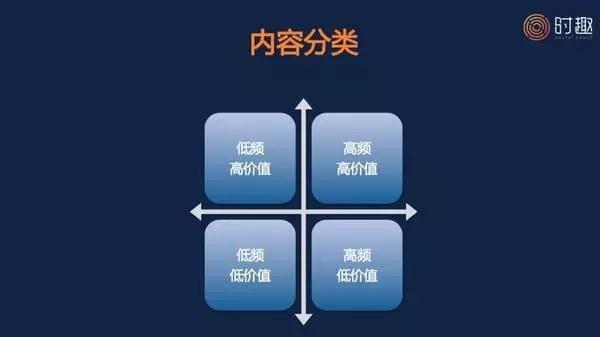In traditional 4A advertisement companies, excellent contents have three basic features, namely ROI (Relevance, Originality, and Impact).
In the mobile social era, good contents have the same influence. But they have proposed higher demands for “visibility and communication”, namely to let consumers see the contents among all the information and communicate the contents. From the perspective of company ROI, the contents communicated by the consumers mean a lot of free exposure, which is more valuable than the exposures bought.
Contents can be divided into four types according to the interaction frequency between contents and consumers and the business value generated.

The first type is the contents with a high frequency and high value. To all marketing departments, the most ideal goal of paid contents is to grow from a Cost center to a Profit center.
The second type is the contents with a high frequency and low value. These contents are generally the ordinary contents on WeMedia. In the field of mobile social, frequent contacts are especially important, because the biggest problem with low-frequent contacts is that consumers are easily to forget soon. Consumers should be contacted in high frequency to enhance their memory.
The third type is the contents with a low frequency and high value. For example, the frequency of TVC, advertising videos and big events will not be very high but the business values are huge.
The fourth type is the contents with a low frequency and low value, which should be avoided.
One piece of content must contain three elements, namely point, form and follow-up actions. The simplest method is to find the tear points, teasing points, funny points and angry points.
One point is one basis. The development from two points to three points can spark more discussions. If one incident can cover four points, it can be constantly communicated. These four points are actually the four most classic emotions in social relations:
Funny point: we want to share happiness
Tear point: with sadness, we hope for sympathy.
Teasing point: with panic, we want to seek reliance and reassurance
Angry point: anger drives people to consolidate the alliance
What we have to figure out is to use what kind of contents to trigger it. Emotions can easily bring impulses while impulses will result in actions.
1. Use personified brand to successfully capture users.
Philip Cotler, a modern master in marketing, once pointed out that “A successful and personified brand image is its best public relation department, which can contribute to closer relationships between the company and customers and deepen the customers’ emotions to the brand and its culture. Finally, the brand image in the hearts of customers is not merely a product, but a vivid man even with its own image, personality, disposition and cultural accomplishments.”
Let a brand have its own attitude, temper, personality and mentality and even let it build up its own social circle like human beings. Let it tell stories like human beings to attract users and interact with users. This is the so-called brand personification.
In the process of personification, companies should grasp the sub-cultural opportunities to form the serious segregation. Examples include the ghost culture, scheming and two-dimension cultures that appeal to the young people.
2. Stories of ordinary people will echo more with users.
Most of the users live an ordinary life. Real, natural and emotional stories of ordinary people can touch consumers more. Stories of ordinary people, ordinary emotions and careful works can create more resonances.
In the selection of spokesman for companies, the internal employees, especially the routine work of front-line workers, can touch the consumers more. Take NongFu Spring as an example. The spokesman for its ad named “The Last Mile” is the front-line cargo runners in Tibet. The ad was shot in Tibet to convey the emotions more accurately.
3. Crowd creation and crowdsourcing realize that user participation equals content.
Semi-individualized templates can be designed to invite users to recreate the contents, such as cute faces, footprint, theatre for kids. Scenes of high frequency can also be combined to realize that user participation equals content. Take the cooperation between Master Kong and Codoon as an example. If a runner wears the wristband of Codoon for marathon or running, the running figures can convert into the number of water drops. This is the public welfare event of Master Kong.
Note: This article is excerpted and modified from Wu Xuan’s (COO of Social Touch) sharing on Zhen Talk.